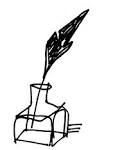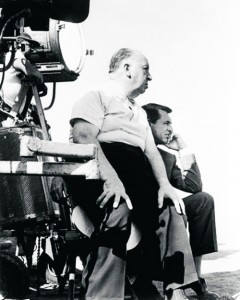 “It is undesirable to have a perfect taste, to respond properly to all the masterpieces. Unless we approach literature demandingly, as I say, unless we respect it for its influence, we fall into the attitude of the dilettante, the epicurean, on the style of the late Bernard Berenson, who by trying to prove that his taste was equal to the best that has been thought and said, made culture look like a table set with tidbits.”
“It is undesirable to have a perfect taste, to respond properly to all the masterpieces. Unless we approach literature demandingly, as I say, unless we respect it for its influence, we fall into the attitude of the dilettante, the epicurean, on the style of the late Bernard Berenson, who by trying to prove that his taste was equal to the best that has been thought and said, made culture look like a table set with tidbits.”
Alfred Kazin, “The Function of Criticism Today”

 Mrs. T and I watched Alfred Hitchcock’s North by Northwest last week for the first time in a number of years. As we did so, I remembered that I’d written an essay about the film in 1998 for Civilization, a long-defunct magazine published by the Library of Congress. It’s never been collected or reprinted. I still like it, and thought you might feel the same way.
Mrs. T and I watched Alfred Hitchcock’s North by Northwest last week for the first time in a number of years. As we did so, I remembered that I’d written an essay about the film in 1998 for Civilization, a long-defunct magazine published by the Library of Congress. It’s never been collected or reprinted. I still like it, and thought you might feel the same way. Today, Hitchcock is accepted as a great filmmaker, but the terms of his acceptance are narrowly framed: Vertigo is the only Hitchcock film ever to have made Sight & Sound’s top-ten list. Granted, Vertigo is a marvel, and surely one of his personal best—but why not North by Northwest, regarded by most Hitchcock buffs as a work of comparable stature? The two films, after all, sum up the two sides of his creative personality: James Stewart, the desperate lover of Vertigo, is perfectly balanced by Cary Grant, the supremely self-confident gent in a jam around whom the plot of North by Northwest swirls madly. Both films are technically dazzling; both have masterly scripts; both were scored by Bernard Herrmann, the film composer’s film composer. So what makes Vertigo the classic and North by Northwest the commercial?
Today, Hitchcock is accepted as a great filmmaker, but the terms of his acceptance are narrowly framed: Vertigo is the only Hitchcock film ever to have made Sight & Sound’s top-ten list. Granted, Vertigo is a marvel, and surely one of his personal best—but why not North by Northwest, regarded by most Hitchcock buffs as a work of comparable stature? The two films, after all, sum up the two sides of his creative personality: James Stewart, the desperate lover of Vertigo, is perfectly balanced by Cary Grant, the supremely self-confident gent in a jam around whom the plot of North by Northwest swirls madly. Both films are technically dazzling; both have masterly scripts; both were scored by Bernard Herrmann, the film composer’s film composer. So what makes Vertigo the classic and North by Northwest the commercial? The only truly illuminating thing I’ve ever read about North by Northwest is a 1970 essay by the late Charles Thomas Samuels, who spoke admiringly of its “contentless virtuosity.” That’s exactly right, and it is for this reason that North by Northwest, which turns forty this year, has stayed as fresh as this morning’s paint. Here’s how Ernest Lehman, who wrote the script, pitched it to Hitchcock: “One day I said, ‘I want to do a Hitchcock picture to end all Hitchcock pictures, that’s the only kind of picture I want to do, Hitch.’ And by that I meant a movie-movie—with glamour, wit, excitement, movement, big scenes, a large canvas, innocent bystander caught up in great derring-do, in the Hitchcock manner.” To which the great man wistfully replied, “I’ve always wanted to do a chase sequence across the faces of Mount Rushmore.” And off they went, unencumbered by the faintest whiff of social consciousness, in search of thrills—and, just as important, laughs.
The only truly illuminating thing I’ve ever read about North by Northwest is a 1970 essay by the late Charles Thomas Samuels, who spoke admiringly of its “contentless virtuosity.” That’s exactly right, and it is for this reason that North by Northwest, which turns forty this year, has stayed as fresh as this morning’s paint. Here’s how Ernest Lehman, who wrote the script, pitched it to Hitchcock: “One day I said, ‘I want to do a Hitchcock picture to end all Hitchcock pictures, that’s the only kind of picture I want to do, Hitch.’ And by that I meant a movie-movie—with glamour, wit, excitement, movement, big scenes, a large canvas, innocent bystander caught up in great derring-do, in the Hitchcock manner.” To which the great man wistfully replied, “I’ve always wanted to do a chase sequence across the faces of Mount Rushmore.” And off they went, unencumbered by the faintest whiff of social consciousness, in search of thrills—and, just as important, laughs. Still, there are many types of greatness, and Alfred Hitchcock’s kind, idiosyncratic though it is, makes the cut with room to spare. His best films are as watchable today as they were a half-century ago, and speak as directly to the case-hardened children of Generation X as they do to graying baby boomers like me. I recently invited a 23-year-old movie buff, raised on fast-moving indie flicks, to watch North by Northwest with me; she’d never seen it, and I wondered if Hitchcock’s carefully calculated pacing would strike her as arthritic. Not a chance. She watched in rapt silence as Cary Grant slithered drunkenly along the edge of a Long Island cliff, made out with Eva Marie Saint on the 20th-Century Limited (with kissing like that, who needs nude scenes?), and choked on clouds of DDT in a deserted prairie cornfield. “Cool!” she said at the end. “That is one totally cool movie.” And so it is, and ever shall be.
Still, there are many types of greatness, and Alfred Hitchcock’s kind, idiosyncratic though it is, makes the cut with room to spare. His best films are as watchable today as they were a half-century ago, and speak as directly to the case-hardened children of Generation X as they do to graying baby boomers like me. I recently invited a 23-year-old movie buff, raised on fast-moving indie flicks, to watch North by Northwest with me; she’d never seen it, and I wondered if Hitchcock’s carefully calculated pacing would strike her as arthritic. Not a chance. She watched in rapt silence as Cary Grant slithered drunkenly along the edge of a Long Island cliff, made out with Eva Marie Saint on the 20th-Century Limited (with kissing like that, who needs nude scenes?), and choked on clouds of DDT in a deserted prairie cornfield. “Cool!” she said at the end. “That is one totally cool movie.” And so it is, and ever shall be. My essay in the May issue of Commentary is occasioned by the publication of Ted Gioia’s
My essay in the May issue of Commentary is occasioned by the publication of Ted Gioia’s 
 Fourteen years after it was set to open on Broadway, “The Visit,” the final John Kander-Fred Ebb musical, has gotten there at last, extensively reworked along the way by Mr. Kander, the composer, and Terrence McNally, who wrote the book. (Ebb, who wrote the lyrics, died in 2004.) This production, previously seen last summer at the Williamstown Theatre Festival, was worth the wait. Directed by John Doyle, the master of miniaturized musicals, and starring Chita Rivera, who made her Broadway debut 62 years ago and still has what it takes, “The Visit” is a cynical tragicomedy whose score is as gorgeous as its heart is hard. If that’s your cup of arsenic, you’ve come to the right apothecary.
Fourteen years after it was set to open on Broadway, “The Visit,” the final John Kander-Fred Ebb musical, has gotten there at last, extensively reworked along the way by Mr. Kander, the composer, and Terrence McNally, who wrote the book. (Ebb, who wrote the lyrics, died in 2004.) This production, previously seen last summer at the Williamstown Theatre Festival, was worth the wait. Directed by John Doyle, the master of miniaturized musicals, and starring Chita Rivera, who made her Broadway debut 62 years ago and still has what it takes, “The Visit” is a cynical tragicomedy whose score is as gorgeous as its heart is hard. If that’s your cup of arsenic, you’ve come to the right apothecary. Mr. Kander’s soaring, waltz-scented love songs are harmonized in an off-center manner subtly suggestive of dirty work at the crossroads. (Imagine a carton of cream that’s a day away from curdling and you’ll get the idea.) As for Ms. Rivera, who sounds like a cross between Hermione Gingold and Rex Harrison and is made up to resemble a walking mummy, she’s all too terrifyingly believable as Claire. When she assures Anton that “I’ve waited a lifetime for this moment,” you’ll feel your insides shriveling.
Mr. Kander’s soaring, waltz-scented love songs are harmonized in an off-center manner subtly suggestive of dirty work at the crossroads. (Imagine a carton of cream that’s a day away from curdling and you’ll get the idea.) As for Ms. Rivera, who sounds like a cross between Hermione Gingold and Rex Harrison and is made up to resemble a walking mummy, she’s all too terrifyingly believable as Claire. When she assures Anton that “I’ve waited a lifetime for this moment,” you’ll feel your insides shriveling. Even after Henry became rich, the Folgers lived simply in a rented Brooklyn house. Instead of trying to buy their way into society, they sank their money into the collection and, later, the building where it can now be viewed by the public. As a result, Ms. Mays writes, they were never able to fully appreciate their holdings: “Once Henry and Emily had stuffed the rooms and closets of their modest home full of Shakespeariana, they had to banish the bulk of their treasures to warehouses, perhaps never to be seen by them again.”
Even after Henry became rich, the Folgers lived simply in a rented Brooklyn house. Instead of trying to buy their way into society, they sank their money into the collection and, later, the building where it can now be viewed by the public. As a result, Ms. Mays writes, they were never able to fully appreciate their holdings: “Once Henry and Emily had stuffed the rooms and closets of their modest home full of Shakespeariana, they had to banish the bulk of their treasures to warehouses, perhaps never to be seen by them again.”